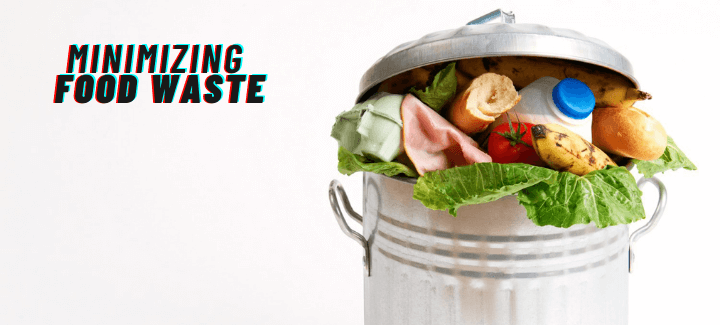
Food safety and wastage are of necessary concern all over the world. Every year many people fall sick due to foodborne illnesses. Additionally, a lot of food gets wasted due to various reasons. The causes of food wastage are:
As per Feeding America – 108 billion pounds of food is wasted in the United States each year. Out of which, 40% wastage occurs from Consumer-facing Businesses.
Global food wastage almost costs up to 2.6 trillion USD per year. It is thus the responsibility of every commercial food set up to reduce food wastage. This will protect the environment and save the cost of production for the food.
All pantry staff must have training on buying, storing, and properly cooking food to ensure food safety. Strict food safety and hygiene practices must be in place for one and all working in the pantry. Also, staff must have complete knowledge of food safety and foodborne illnesses.
To prevent wastage, the staff procuring the food items must only accept fresh foods. Avoid cross-contamination by using separate equipment and utensils to prepare food. Staff must throw out stale food and food with foul odors to prevent food contamination. Enforcing Utah food handlers permit can help to maintain food safety and cut food wastage. Provide training to staff on food safety and ensure that they are well informed on food safety norms.
Restaurants should buy ingredients in quantities that they will use immediately or shortly. Sometimes, to earn more profits, the supplier offers tempting and better deals on bulk buy. In turn, this leads to unnecessary buying of food items. Moreover, the extra food may get spoiled in the storage, leading to food wastage based on the shelf life. It is thus imperative to avoid over-purchasing of food ingredients.
Food handlers should be well informed on the availability of food stock in the pantry.
It is often seen in various food setups that almost 21% of food gets wasted because of food spoilage.
Hence there should be proper tracking of the food stock coming in and used by the restaurant.
Recommendation: Keeping Your Restaurant Kitchen Clean and Up to Code
Proper temperature control is essential for food safety. One should check & assure that refrigerators, cold storage operate at the correct temperatures. It helps prevent food decay, spoilage, and waste due to mold and bacterial growth. It is advisable to follow and maintain the proper hygiene norms of the food storage units. One must make sure that the food storage areas are always neat and tidy.
Ensure to store high-risk food items on the lower shelves of freezers and cold storage. Likewise, store the low-risk food items on the upper shelves of the refrigerators. Ensure the food storage area is free of pests to prevent pest infestations.
Follow the ‘FIFO’ rule – First In, First Out rule when storing and displaying food for sale. This principle ensures that the new stock is always behind the older stock. This practice enables the usage of older food items first. Implementing the FIFO rule eliminates any chances of food spoilage or food wastage.
This is an essential lesson in the food certification course in Utah. Every packaged food comes with use by and best before dates. These dates imply the time or the specific date till which food is safe to consume. A list displaying food use by, best before, or expiry dates on the restaurant pantry should help the staff keep a check. It will enable kitchen workers to use them before the food gets stale and unsafe to use. One must check these dates while procuring food products for the pantry. This ensures only safe food is available for consumption and prevents food wastage.
Ensure to divide the food items into different containers to store them properly. Each container should have a label with complete information on the food product. It should have information on nutritional value, expiry dates, and allergy warnings. Labeling food containers prevents cross-contamination when you store them. This way, it’s easier to track food items with their respective product descriptions.
While receiving the stocks, ensure to receive only the items as per the requisition list. It is also recommended to cross verify and check all the food items. This exercise will allow you to reject food items with visible spoilage. Always reject foods that leak or have damaged packaging. Never accept any food with a strange color, smell, or food product stored at the wrong temperature.
Every year, tons of food gets wasted in restaurants while many people stay hungry. The restaurants should donate the leftover and unused food for the set of people who need it. Restaurant owners must ensure that the food they donate is fresh and safe to consume. Hence, restaurants should collaborate with local food banks. Food banks collect unused food from restaurants and food outlets daily. This way, leftover food reaches the right people rather than going to waste.
Restaurants adopt large batch cooking to save time, but at times it leads to food wastage. Restaurants should analyze their customer behavior and prepare food in the required quantity. This will ensure that all prepared food will get used before it gets stale. Also, restaurants must provide a made-to-order option for consumers to avoid wastage.
By following simple food safety norms, restaurants can prevent food from spoiling. Food handlers must develop guidelines for the pantry team to maintain food safety. Food safety procedures must be in place at different levels of food preparation, such as buying, storing, and cooking. It helps prevent cross-contamination and foodborne illnesses. Restaurants must follow state health guidelines for food wastage. Ensure that procedures must be in place in all food setups to reduce the risk of foodborne diseases.